Table of Contents
Introduction
According to Set-Top Box Statistics: Set-top boxes (STBs) are crucial devices in the television sector, decrypting digital signals and granting access to a diverse array of content. Major participants in this fiercely competitive market encompass Cisco Systems, Technicolor, ARRIS International, and Huawei.
The worldwide STB industry has displayed consistent expansion due to the transition to digital broadcasting, the adoption of 4K resolution, and the integration of intelligent features. Progressions like voice command and DVR functions have enriched user interactions.
Despite facing competition from streaming gadgets, STBs identify prospects in emerging markets and tailor solutions for content providers, marking it as a developing field.
Editor’s Choice
- The global set-top box market is poised for steady growth over the coming years at a CAGR of 4.1%, as indicated by the projected revenues.
- In 2023 the market is estimated to be worth approximately USD 25.01 billion.
- The majority of market share is attributed to offline channels, accounting for a substantial 78%.
- North America commands a substantial 22.0% market share, underscoring its significance as a key player in the industry.
- Among market players, Ecostar Corporation leads the pack with a significant market share of 14%, showcasing its prominence in the market.
- In the current landscape, approximately 32% of viewers opt to kickstart their video content experience by launching a smart TV app, marking a substantial 10% increase from the 22% recorded in 2021.
- As of Q2 2021, Android TV’s middleware was present on approximately 26% of advanced set-top boxes worldwide, which accounts for roughly 5% of all boxes, including older legacy devices.
Set Top Box Market Overview
Global Set Top Box Market Size
- The global set-top box market is poised for steady growth over the coming years at a CAGR of 4.1%, as indicated by the projected revenues.
- In 2023, the market is estimated to be worth approximately USD 25.01 billion.
- Over the subsequent years, the market is anticipated to experience consistent expansion, with revenues reaching USD 29.37 billion in 2027, USD 30.58 billion in 2028, and further climbing to USD 34.49 billion by 2031.
- This growth trend underscores the resilience and potential of the set-top box industry, with gradual but significant increases in market value projected throughout the forecast period, ultimately culminating in a value of approximately USD 37.38 billion by 2032.
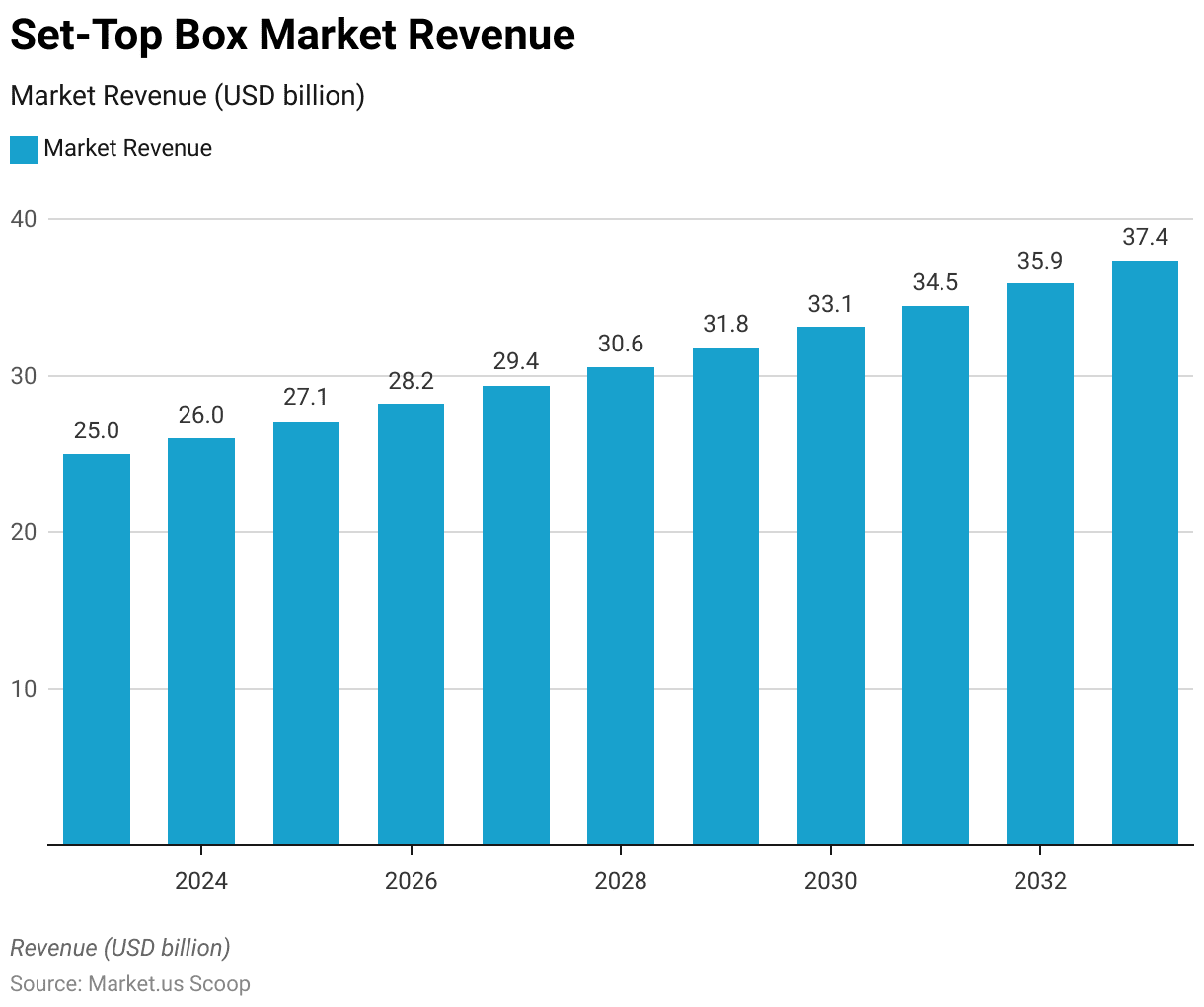
Global Set Top Box Market Share- By Distribution Channel
- In the global set-top box market, the distribution channels play a pivotal role in reaching consumers.
- The majority of market share is attributed to offline channels, accounting for a substantial 78%.
- This highlights the significance of traditional retail outlets and physical stores in distributing set-top box products to consumers.
- On the other hand, online distribution channels hold a noteworthy 22% market share.
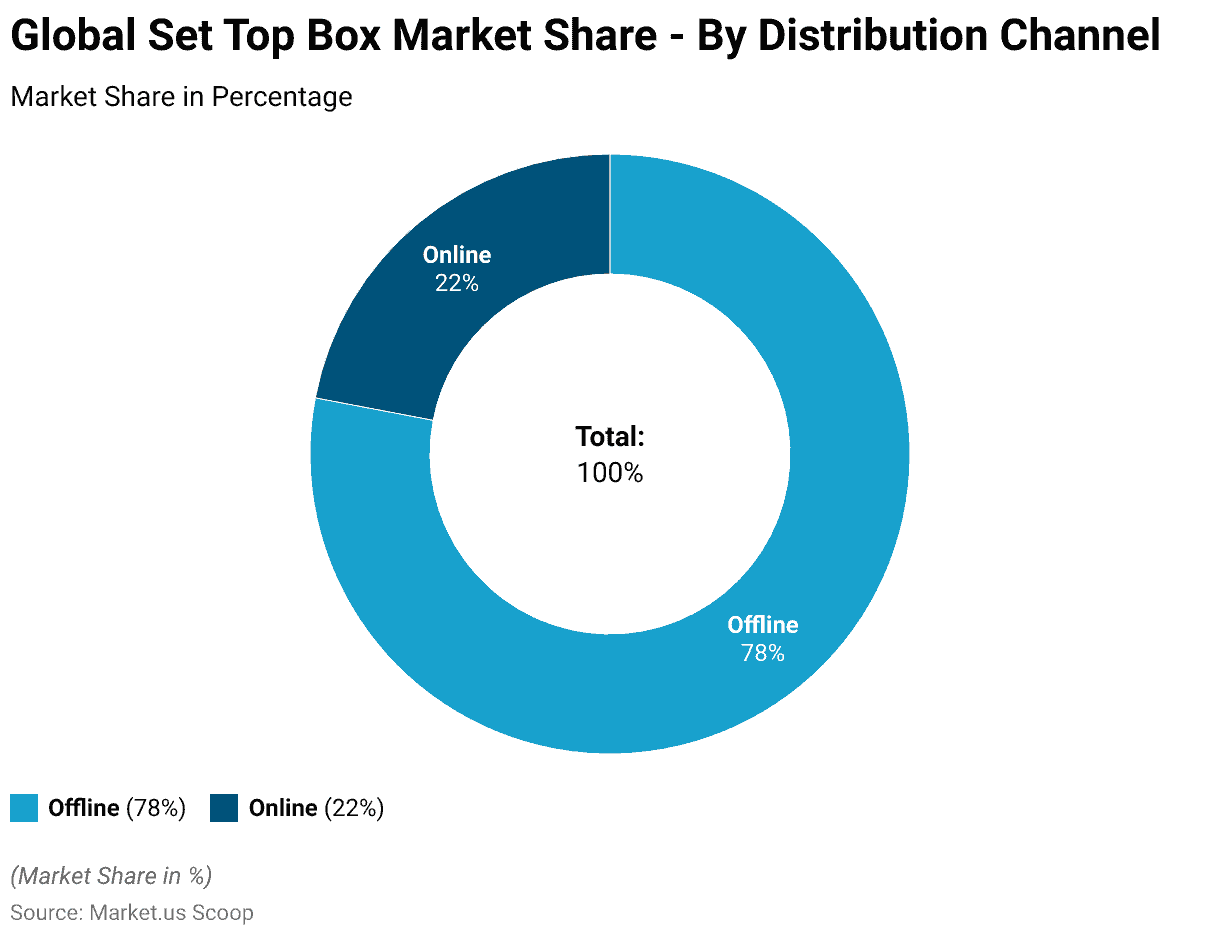
Regional Analysis of Set Top Box Market
- A comprehensive regional analysis of the set-top box market reveals distinct market shares across different geographical regions.
- North America commands a substantial 22.0% market share, underscoring its significance as a key player in the industry.
- Meanwhile, Europe holds a significant portion, accounting for 28.0% of the market, showcasing its robust presence in the market landscape.
- The Asia-Pacific (APAC) region emerges as a dominant force, boasting the largest market share at 35.0%, reflecting its vast consumer base and growing demand for set-top box solutions.
- In Latin America, the market share stands at 7.5%, while the Middle East and Africa (MEA) region contributes 3.0% to the global market.
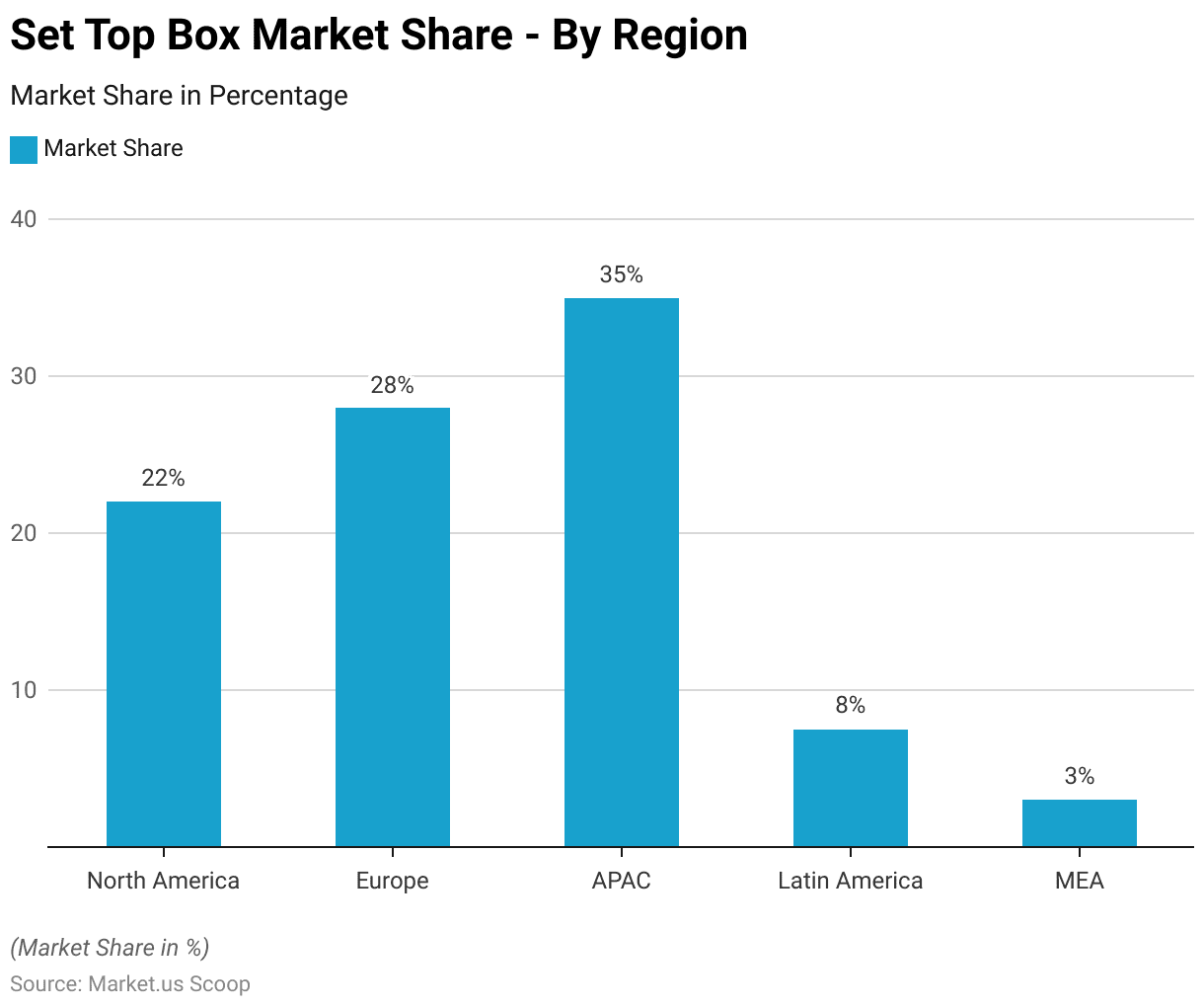
Key Players in the Global Set Top Box Market
- The global set-top box market is characterized by a diverse landscape of key players, each contributing to the industry’s growth and innovation.
- Among these, Ecostar Corporation leads the pack with a significant market share of 14%, showcasing its prominence in the market.
- Following closely behind are Skyworth Group and ARRIS International, with market shares of 12% and 11% respectively, demonstrating their substantial influence and competitive positions.
- Huawei Technologies Ltd. and Samsung Electronics Ltd. each hold a notable 10% market share, highlighting their strong presence in the market.
- HUMAX and CISCO Systems Inc. contribute 10% and 9% of the market share, respectively, further adding to the diversity of players in the sector.
- Additionally, DISH Network holds an 8% market share, while other key players collectively account for 15% of the market.
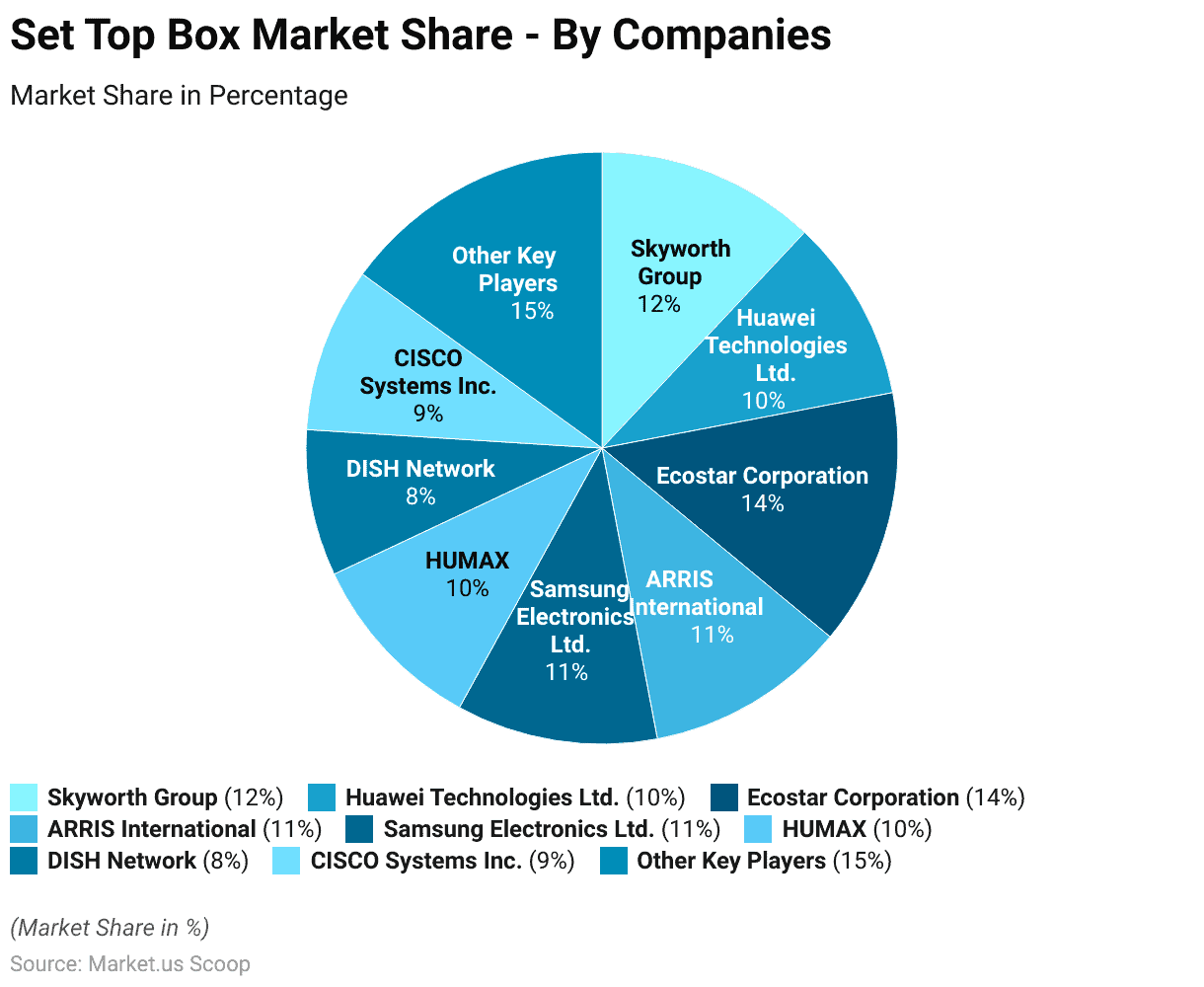
TV Set-top Box Shipments Statistics
- From 2012 to 2019, the global market for TV set-top boxes witnessed significant growth across various regions.
- In North America, the shipments of these devices steadily increased from 10.7 million units in 2012 to 17.5 million units in 2019, reflecting a consistent upward trend.
- Similarly, Europe experienced substantial growth in set-top box shipments, with numbers rising from 13.9 million units in 2012 to an impressive 38.7 million units in 2019.
- However, the most remarkable expansion was observed in the Asia Pacific region, where shipments soared from 34.2 million units in 2012 to a staggering 139.5 million units in 2019, underlining the growing demand for TV set-top boxes in this market.
- In Latin America, while the numbers started relatively low in 2012 at 1.1 million units, they steadily increased to reach 15 million units by 2019.
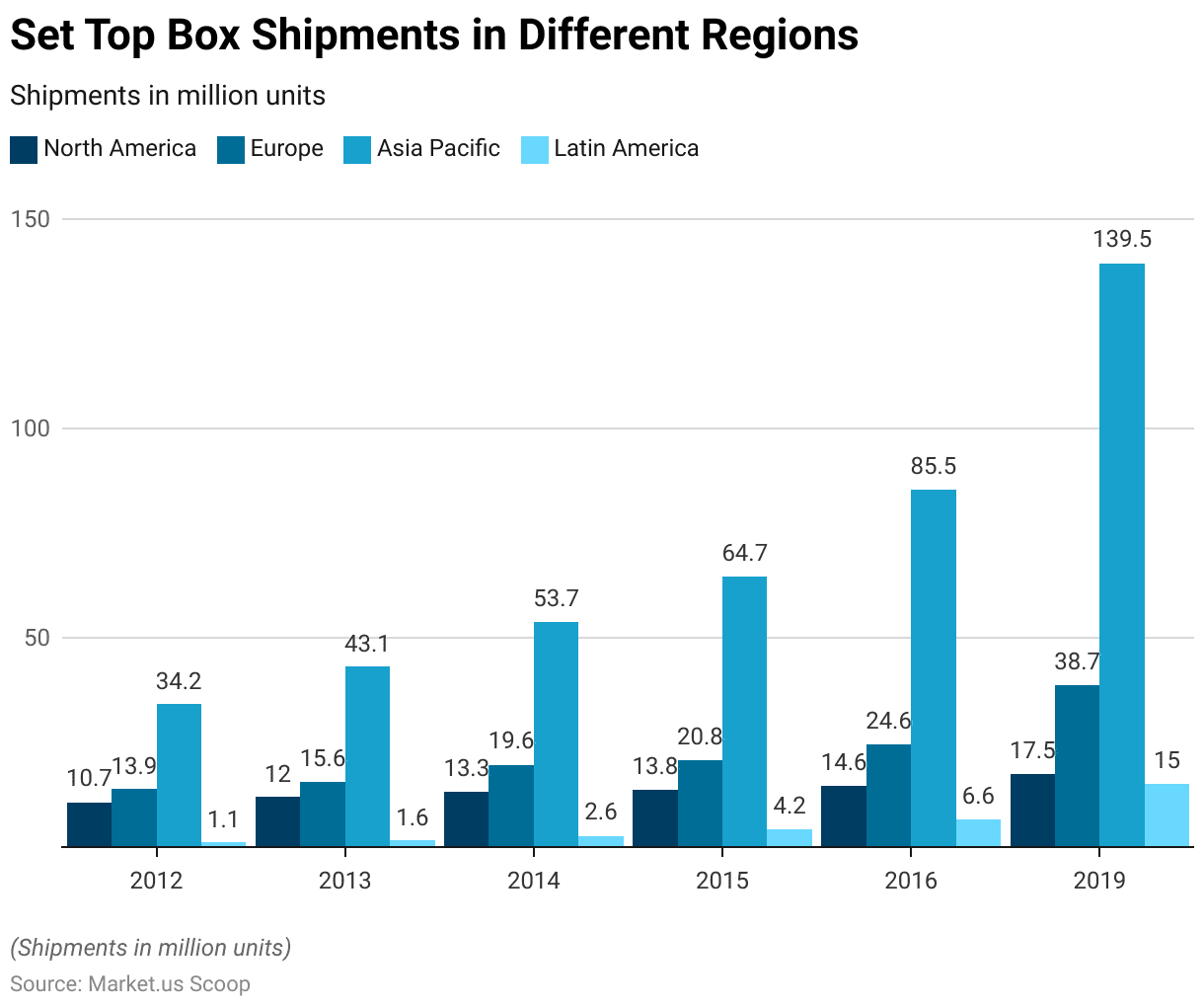
Set Top Box Consumer Preferences Statistics
- Examining the trends in how viewers initiate their video content viewing reveals notable shifts.
- In the current landscape, approximately 32% of viewers opt to kickstart their video content experience by launching a smart TV app, marking a substantial 10% increase from the 22% recorded in 2021.
- Conversely, the set-top box, encompassing live TV, video-on-demand (VOD), and DVR functionality, remains a preferred starting point for a significant portion of viewers at 30%.
- However, this figure represents a noteworthy decline from the 41% observed in 2021.
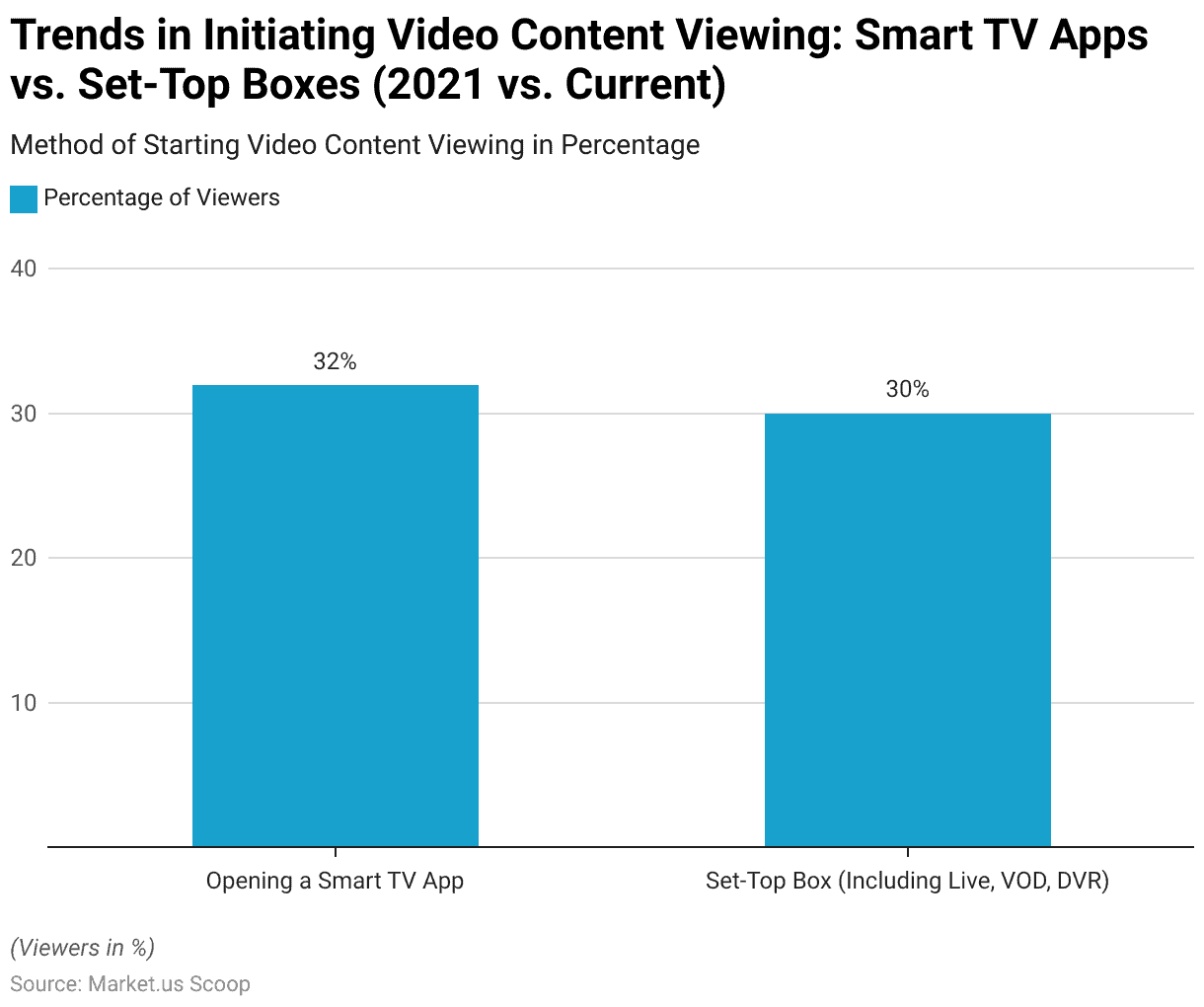
Advanced Set-top Box Statistics
Installed Advanced Set-top Boxes
- As of Q2 2021, Android TV’s middleware was present on approximately 26% of advanced set-top boxes worldwide, which accounts for roughly 5% of all boxes, including older legacy devices.
- However, this statistic conceals a somewhat disputed situation: the share of Google’s platform in the overall advanced set-top box market declined from 40% in 2015.
- It faced growing competition from alternative solutions, notably the Reference Design Kit (RDK), a software platform endorsed by prominent cable companies, and advanced Linux-based options.
Installed Advanced Set-top Boxes – By Region
- Asia-Pacific leads in the deployment of Android pay-TV devices, accounting for nearly 70% of the total in Q2 2021.
- Meanwhile, in Europe, Android set-top boxes find favor among subscribers. This popularity in Europe can be attributed to the presence of numerous small and medium-sized operators keen on offering flexible services that cater to their customers’ desires for added options and applications.
- In Latin America, Africa, and the Middle East, the adoption of advanced set-top boxes lags due to smaller pay TV markets and less prevalent OTT consumption compared to Europe and North America.
- In North America, the Reference Design Kit (RDK) has held a dominant position, thanks primarily to a handful of major operators like Comcast, Charter Group, and Rogers Group. Unlike Android TV, RDK has a smaller operator base.
Share of Worldwide Forecast – By Device Type (Installed base)
- Examining the share of the worldwide forecast for installed base by device type in 2017 and 2021 reveals interesting trends.
- In 2017, smart televisions constituted the majority, accounting for 73.5% of the installed base. By 2021, while still dominant, their share had decreased slightly to 70.7%.
- Streaming media players, on the other hand, occupied a smaller segment in 2017, with 6.3%, which further reduced to 3% by 2021.
- In contrast, set-top boxes experienced significant growth, rising from 14.7% in 2017 to 24.8% in 2021.
- Microgame consoles and other devices, while present, held relatively minor shares in both years, with a noticeable decrease in the case of microgame consoles from 5.1% in 2017 to 1.4% in 2021, and a marginal drop for other devices from 0.4% to 0.1% during the same period.
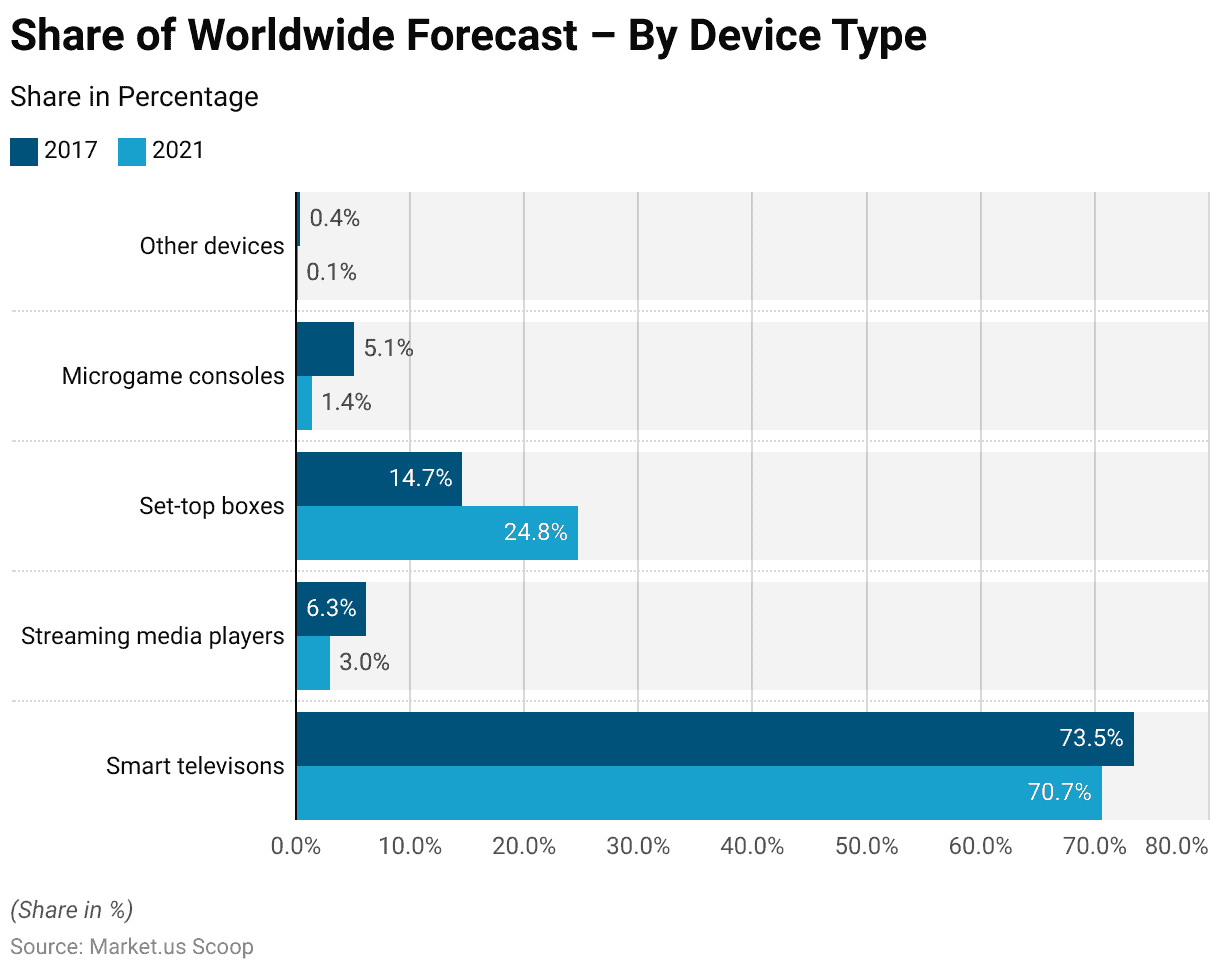
Set Top Box Energy Consumption in Households
- To enable the simultaneous viewing of different programs on multiple TVs, many households possess two or more Set-Top Boxes (STBs).
- This leads to an annual household energy consumption ranging from 300 to 400 kWh, approaching the energy usage of a new refrigerator in a year.
- When you factor in the energy consumed by the TV itself and other home entertainment devices, the total energy usage related to home entertainment components can easily surpass 1,000 kWh per year, equivalent to the energy consumed by two new refrigerators annually.
- This represents roughly 10% of a typical household’s electricity consumption, exceeding the energy used to illuminate the entire home throughout the year.
Potential Energy Savings
- By making minimal changes without redesigning other Set-Top Box (STB) components, it’s possible to enhance power supply efficiency to 85%.
- This adjustment would result in initial savings of 156 million kWh in the first year and a cumulative impact of 1.4 billion kWh over four years.
- On average, each box would save $12 per year on utility bills under this scenario.
Discuss your needs with our analyst
Please share your requirements with more details so our analyst can check if they can solve your problem(s)



